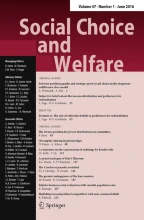Abstract
An alternative is said to be a Condorcet winner of an election if it is preferred to any other alternative by a majority of voters. While this is a very attractive solution concept, many elections do not have a Condorcet winner. In this paper, we propose a set-valued relaxation of this concept, which we call a Condorcet winning set: such sets consist of alternatives that collectively dominate any other alternative. We also consider a more general version of this concept, where instead of domination by a majority of voters we require domination by a given fraction \(\theta \) of voters; we refer to such sets as \(\theta \)-winning sets. We explore social choice-theoretic and algorithmic aspects of these solution concepts, both theoretically and empirically.
Similar content being viewed by others
Notes
This complexity class consists of problems that can be solved in time \(2^{O((\log n)^c)}\) for some constant \(c\) on an input of size \(n\), and includes, in particular, the minimum dominating set problem (Megiddo and Vishkin 1988).
References
Alon N, Brightwell G, Kierstead HA, Kostochka AV, Winkler P (2006) Dominating sets in \(k\)-majority tournaments. J Comb Theory Ser B 96(3):374–387
Alon N, Spencer J (1992) Probabilistic method. John Wiley, Hoboken
Betzler N, Slinko A, Uhlmann J (2013) On the computation of fully proportional representation. J Artif Intell Res 47:475–519
Cervone D, Hardin C, Zwicker W (2012) Personal communication
Cervone D, Zwicker W (2011) Personal communication
Chamberlin JR, Courant PN (1983) Representative deliberations and representative decisions: proportional representation and the Borda rule. Am Polit Sci Rev 77(3):718–733
Cornaz D, Galand L, Spanjaard O (2012) Bounded single-peaked width and proportional representation. In: Proceedings of the 20th European conference on artificial intelligence (pp 270–275)
Elkind E, Faliszewski P, Skowron P, Slinko A (2014) Properties of multiwinner voting rules. In: Proceedings of the 13th international conference on autonomous agents and multiagent systems (pp 53–60)
Fishburn P (1981) An analysis of simple voting systems for electing committees. SIAM J Appl Math 41(3):499–502
Garey M, Johnson D (1979) Computers and intractability: a guide to the theory of NP-completeness. W. H. Freeman and Company, New York
Gehrlein W (1985) The Condorcet criterion and committee selection. Math Soc Sci 10(3):199–209
Geist C (2014) Finding preference profiles of Condorcet dimension k via SAT. arXiv:1402.4303
Jones B, Radcliff B, Taber C, Timpone R (1995) Condorcet winners and the paradox of voting: probability calculations for weak preference orders. Am Polit Sci Rev 89(1):137–144
Kaymak B, Sanver R (2003) Sets of alternatives as Condorcet winners. Soc Choice Welf 20(3):477–494
Laforest C (2012) Personal communication
Laslier J-F (1997) Tournament solutions and majority voting. Springer, New York
Lu T, Boutilier C (2011) Budgeted social choice: from consensus to personalized decision making. In: Proceedings of the 22nd international joint conference on artificial intelligence
McGarvey D (1953) A theorem on the construction of voting paradoxes. Econometrica 21(4):608–610
Megiddo N, Vishkin U (1988) On finding a minimum dominating set in a tournament. Theor Comput Sci 61:307–316
Monroe BL (1995) Fully proportional representation. Am Polit Sci Rev 89:925–940
Procaccia A, Rosenschein J, Zohar A (2008) On the complexity of achieving proportional representation. Soc Choice Welf 30(3):353–362
Ratliff T (2003) Some startling inconsistencies when electing committees. Soc Choice Welf 21(3):433–454
Scott A, Fey M (2012) The minimal covering set in large tournaments. Soc Choice Welf 38(1):1–9
Skowron P, Faliszewski P, Slinko A (2013a) Achieving fully proportional representation is easy in practice. In: Proceedings of the 12th international conference on autonomous agents and multiagent systems (pp 399–406)
Skowron P, Faliszewski P, Slinko A (2013b) Fully proportional representation as resource allocation: approximability results. In: Proceedings of the 23rd international joint conference on artificial intelligence (pp 353–359)
Skowron P, Yu L, Faliszewski P, Elkind E (2013) The complexity of fully proportional representation for single-crossing electorates. In: Proceedings of the 6th international symposium on algorithmic game theory (pp 1–12)
Tideman T (1987) Independence of clones as a criterion for voting rules. Soc Choice Welf 4(3):185–206
Yu L, Chan H, Elkind E (2013) Multiwinner elections under preferences that are single-peaked on a tree. In: Proceedings of the 23rd international joint conference on artificial intelligence (pp 425–431)
Acknowledgments
Some of the results of this paper were previously presented at the 22nd International Joint Conference on Artificial Intelligence (IJCAI’11) under the title “Choosing Collectively Optimal Sets of Alternatives Based on the Condorcet Criterion”, and we would like to thank the anonymous referees of IJCAI’11 and Social Choice and Welfare for their helpful comments. We also thank Bruno Escoffier, Ron Holzman, Christian Laforest, Jean-François Laslier, Hervé Moulin, Remzi Sanver and Bill Zwicker for useful discussions. Abdallah Saffidine thanks the Australian Research Council’s (ARC) Discovery Projects funding scheme (project DP 120102023). Part of this work was done when Edith Elkind was affiliated with Nanyang Technological University (Singapore) and supported by National Research Foundation (Singapore) under grant RF2009-08 and by NTU start-up grant.
Author information
Authors and Affiliations
Corresponding author
Rights and permissions
About this article
Cite this article
Elkind, E., Lang, J. & Saffidine, A. Condorcet winning sets. Soc Choice Welf 44, 493–517 (2015). https://doi.org/10.1007/s00355-014-0853-4
Received:
Accepted:
Published:
Issue Date:
DOI: https://doi.org/10.1007/s00355-014-0853-4
